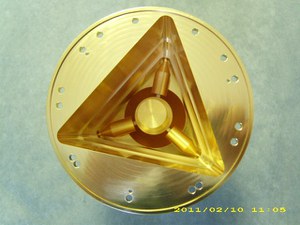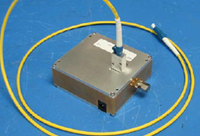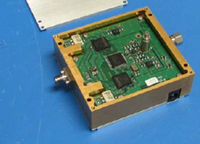Integrated Receivers - Novel architectures to meet future challenges

S-band (1.7-2.6 GHz) digital OMT based on triangular waveguide for large spurious-mode-free bandwidth. This unit also incorporates a coaxial input for calibration signal injection.
The extreme demands of future instrumentation (e.g. large-format focal plane arrays) and facilities (the SKA) require consideration of innovative receiver architectures. The current vision of the next generation, optimally-integrated receiver incorporates a cryogenically-cooled, novel orthomode transducer topology based on triangular waveguide (having wider single-mode bandwidth than conventional geometries), followed by a warm integrated receiver that performs all conversions from RF-to-baseband, from analog-to-digital, and from copper-to-fiber in a single, compact module. This concept has the potential to improve state-of-the-art receiver noise temperatures by 10-20% in the cm-wave range via reduced passive loss between the cryogenic amplifiers and the feed, while giving up nothing in functionality. Scientific observations would benefit from better intrinsic performance in terms of noise temperature, polarization purity, and longevity of calibrations.
Integrated Receiver Development Areas:
- Develop ultra-wideband feeds and digital OMTs
- Develop digitization techniques (such as unformatted digital links) to allow for compact, low-power, and more stable receivers
- Develop techniques and components for more highly integrated receivers, such as flexible thermal transitions and cascaded LO distribution


The precision of digital signal manipulation will be complemented by the stability of end-to-end electronic integration that breaks down the traditional barriers between analog, digital, and fiber optic subsystems.




Connect with NRAO